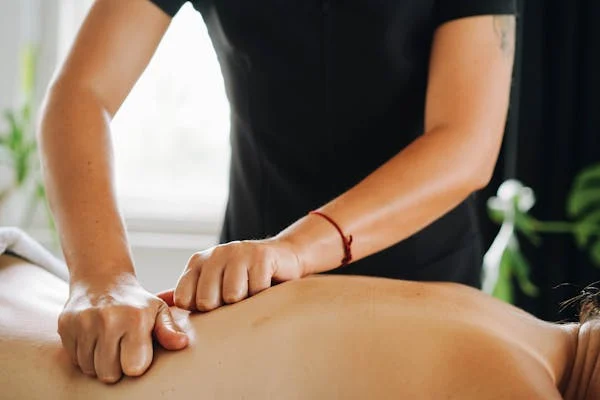Athletes strive to maximize their potential, pushing their bodies to the edge for optimal performance. However, what makes all the difference is the long-term conditioning of the body, where massages are becoming an integral part.
Many US cities, like Denver, are churning out champion players year after year. It is a sports haven, boasting over six professional teams across various sports. From basketball to rugby, fans can witness world-class athletes in action.
The grueling nature of tournaments and contracts makes recovery crucial for athletes at all levels. In such cases, seeking local massage therapy in Denver, CO, can make all the difference.
This is just one example. Massages are not restricted to professionals only. From elite Olympians to weekend warriors, athletes are discovering the myriad benefits of skilled hands working out knots.
In this article, we will explore how massage therapy can give athletes the edge they need to excel and recover faster.

Sports massage stands apart from other massage modalities. It's tailored specifically for athletes' unique needs. Unlike relaxation massages, sports massage includes vigorous techniques to prepare muscles for action or aid recovery.
What sets it apart? Sports massage focuses on areas of the body most stressed by a particular sport. A tennis player might receive extra attention on their serving arm, while a runner's legs would be the primary focus.
Some common techniques include deep tissue work and trigger point therapy. Deep tissue therapy applies substantial pressure to the underlying layers of muscle tissue. This breaks down adhesions and alleviates tension. Trigger-point therapy concentrates on locating and addressing certain areas of pain or sensitivity within the muscles.
Myofascial release is one technique that is getting a lot of traction. According to the Cleveland Clinic, this technique addresses restrictions in the connective tissue surrounding muscles, promoting improved mobility and function.
These methods target muscle knots, increase flexibility, and improve range of motion.
The timing of sports massage matters too. Pre-event massages aim to warm up muscles and boost circulation. They tend to be brief and stimulating. Post-event massages, on the other hand, emphasize recovery. They help flush out toxins, reduce muscle soreness, and promote relaxation.
Understanding these nuances allows athletes to harness the full potential of sports massage for their training and competition needs.
Massage isn't just about feeling good—it can boost athletic performance. How? Let's break it down.
Verywell Health states that massage improves flexibility and range of motion. Working out muscle knots and adhesions allows athletes to move more freely. This can lead to better technique and reduced risk of injury.
Circulation is another key benefit. Massage increases blood flow to muscles, delivering more oxygen and nutrients. This can enhance endurance and power output during competition.
But the benefits aren't just physical. According to Governor’s Park Chiropractic, massages have a profound impact on mental state too. It reduces stress hormones like cortisol while boosting feel-good chemicals like serotonin. This can improve focus, better sleep, and reduce anxiety before big events.
Moreover, reducing muscle tension can also improve neuromuscular communication. Athletes may be able to recruit more muscle fibers during activity. These combined effects make massage a powerful tool for athletes seeking to enhance their performance.
Massages enhance circulatory and lymphatic function. According to Medical News Today, they help in lymphatic drainage. It is a process where metabolic byproducts such as lactate and inflammatory cytokines are discharged.
For healing injuries, massage does more than just feel good. It stimulates tissue repair and helps prevent excessive scarring. A technique called cross-fiber friction can break up scar tissue, leading to faster and more complete healing.
Regular massage can even improve an athlete's sense of body position, known as proprioception.
WebMD states that proprioception is the body's internal sense of movement, position, and orientation. It enables us to perform tasks like walking, reaching, and balancing without conscious thought.
This essential sensory function relies on information from various sources, including muscles, tendons, joints, and the inner ear. Proprioception plays a vital role in maintaining balance, coordination, and overall motor control, and hence in preventing injuries.
By making massage a part of their recovery routine, athletes can bounce back quicker from intense training and competitions. This can help them maintain top performance throughout their season.
By integrating massage into their recovery protocols, athletes can expedite physiological restoration. Moreover, they can mitigate delayed-onset muscle soreness and maintain optimal performance throughout their competitive seasons.
Massage therapy is not a cure for chronic pain conditions. However, it can provide significant relief by reducing muscle tension, improving circulation, and promoting relaxation. It's essential to consult with a healthcare professional to determine if massage therapy is suitable for your specific condition.
No, sports massage benefits athletes of all levels, from elite competitors to recreational enthusiasts. It can help improve performance, reduce injuries, and accelerate recovery for anyone who engages in physical activity, regardless of their skill level or experience. Whether you're a seasoned marathon runner or a casual weekend warrior, sports massage can provide tailored benefits to enhance your athletic journey.
The frequency of sports massages depends on individual needs and goals. Some athletes may benefit from weekly massages, while others may find that monthly sessions are sufficient. It's best to consult a qualified massage therapist to determine the optimal frequency for your specific circumstances.
Incorporating massage therapy into your athletic routine can yield significant benefits for performance and recovery. By understanding the various techniques and their applications, athletes can harness the power of massage to optimize their physical and mental well-being.
From enhancing flexibility and reducing muscle soreness to improving circulation and promoting relaxation, massage therapy proves to be a holistic approach to athletic development.
By prioritizing self-care and seeking the expertise of qualified massage therapists, athletes can unlock their full potential and achieve lasting success.